Here’s the left front
“Don’t mince words, don’t be evasive
Speak your mind, be persuasive”
Madonna
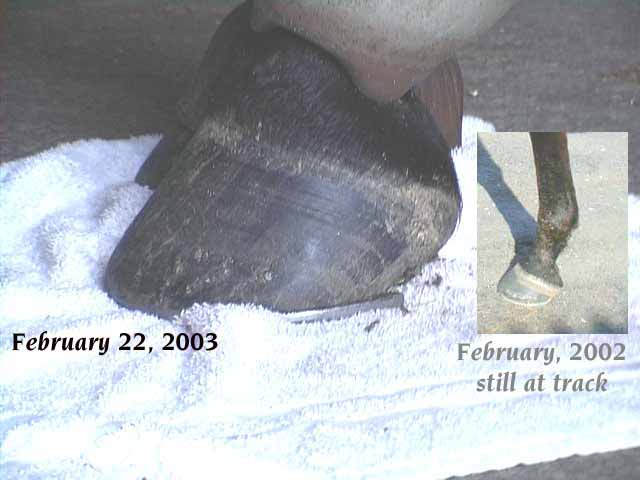

Here’s the left front
“Don’t mince words, don’t be evasive
Speak your mind, be persuasive”
Madonna

<BLOCKQUOTE class=“ip-ubbcode-quote”><font size="-1">quote:</font><HR>Originally posted by nikki3:
…Well the last time he was here, he cut my mares rt front so short that (with shoes on) her frog was touching the ground.<HR></BLOCKQUOTE>
Check back a few pages for the new hoof balance information. Also www.hopeforsoundness.com trim tutorial. Both indicate that optimal function requires that the frog touch the gound…however, there is a right way and a wrong way to accomplish this.
<BLOCKQUOTE class=“ip-ubbcode-quote”><font size="-1">quote:</font><HR>She was foot sore for a good two weeks (first all the time, then only when the ground was frozen) Then we had a few weeks of relative calm.<HR></BLOCKQUOTE>
This, obviously, was not the right approach for getting the frog to touch the gound…sounds like he cut her too short. What you experienced was common.
<BLOCKQUOTE class=“ip-ubbcode-quote”><font size="-1">quote:</font><HR>Due to the weather I did not ride during this time, but I turned her out and put her up each day, and she was fine. As the feet started to grow back in, they did not match.<HR></BLOCKQUOTE>
OK, only hazarding a guess on this, but from what I can see, it seems that when the foot grew back in, that it started to attain a more correct angle. But, the thing that puzzels me is that it must have been at this angle all along…it didn’t have time to grow a whole new angle in 7 weeks. Most likely, it just became noticable after this trim. The toe is still to long, but the angle is much improved over the other foot. The red lines on the right foot are the angles of the left foot superimposed. The yellow lines are much closer to optimal form…but since each horse is different, I can’t say how close they are.
The left foot is much to long in toe and low in angle. Notice the dish in the left toe? This shows that the bottom of the hoof wall is starting to flare away from the optimal parallel position with the coffin bone. I’m guessing that there is some white line separation under the shoe in the toe area. This is the same as a flare and should be removed to balance the foot. Also, notice that when a parallel red line is placed on the heel that it fails to match up. Although not every foot has exact matching angles between toe and heel, they should be similar…closer than these.
<BLOCKQUOTE class=“ip-ubbcode-quote”><font size="-1">quote:</font><HR>Monday (a little over 7 weeks since last trim) I go out to the barn and she is lame, swollen right leg, although not hot. Hoof is warm, not hot. It was quite muddy, and I think she twisted/ stepped funny. Anyway I rubbed the leg down and kept her in that day. By evening the swelling was down, leg was tight and she was not as lame. By the next morning she wasn’t “lame”, a little off, taking smaller steps than usual, but no obvious favoring of either limb. That is how it stands now.<HR></BLOCKQUOTE>
Sounds like another option might be an abscess. If her angles were radically changed, foot cut to short, and/or weather conditions were unfavorable (to wet or frozen), then these could all contribute to abscessing. Also, the coronary band problem could either be the abscess trying to break out, or an injury from playing or banging into something.
<BLOCKQUOTE class=“ip-ubbcode-quote”><font size="-1">quote:</font><HR>Farrier comes tommorrow, and I am going to have to say something to him- right now I am inclined to just have him pull her shoes (she only has them on the front) and leave her barefooted until I find a new farrier. Am I over reacting?<HR></BLOCKQUOTE>
Pulling her shoes and getting the feet to come into a more natural form may be a good thing, but can’t say without having been there. I can understand your concern. As far as over reacting…that depends. The form of the feet can be easily changed for the better. However, finding someone who understands how to do it may be a problem. It probably isn’t this guy.
<BLOCKQUOTE class=“ip-ubbcode-quote”><font size="-1">quote:</font><HR>The things that concern me the most are 1) the feet clearly do not match 2) the rt front frog has went from a wonderful springy triangle to a shriveled, shedding one and 3) rt coronary band- what is that??? (see pics)<HR></BLOCKQUOTE>
The feet can be taken back to better form so they “look” alike. However, if you are considering that the left is the better form, it is not.
The heels and toes are too long on both. In the sole pics you can see that the distance from optimal heel placement (which you have not obtained) to the widest part of the foot and then from there to the current point of breakover is about equal distance (black lines/red arrows on side). The red line on the sole indicates where your current heel placement is…it should be moved back to the black line or the widest part of the frog (where the straight edges turn into the rounded part). The blue line shows where optimal breakover should fall…based on what I thought was the toe calous in the picture. This calous protects the tip of the coffin bone and can be used as a landmark for determining point of breakover.
The frog problem appears to be from contraction. The green line between the heels shows how much small that space is than the one on the other foot…much closer to ideal. The heels of that foot appear to be coming in toward the frog and are even tighter than the shoes. Speaking of shoes, if this is time for a reset, I can see quite a bit of hoof wall over the edge of the shoe. Considering it has only been 7 weeks, this seems like the shoe may be to small for the foot. The foot is probably one of those “in between” sizes and the farrier selected a small shoe and fit the foot into it, rather than altering a larger shoe to fit the foot. I must add on this comment, without being there, it is difficult to determine what happened, so this is just a guess. It could also be that the foot grew excessively in that time.
The other foot is also about 1/2 1/2…again from the current point of breakover to the optimal heel placement. However, to accommodate function and correct alignment and weight bearing, the rear of the foot should have more weight bearing surface. Ideal goal would be 1/3 2/3 (front/back).
<BLOCKQUOTE class=“ip-ubbcode-quote”><font size="-1">quote:</font><HR>also- I apologize in advance for posting all these pics, I need help.<HR></BLOCKQUOTE>
That’s ok Nikki…we like pics ![]() Hope this helps you with your farrier. If you have questions maybe we can get them answered before he comes.
Hope this helps you with your farrier. If you have questions maybe we can get them answered before he comes.
Geezzz…keep forgetting to add the pics.
Proud member of the * Hoof Fetish Clique * 
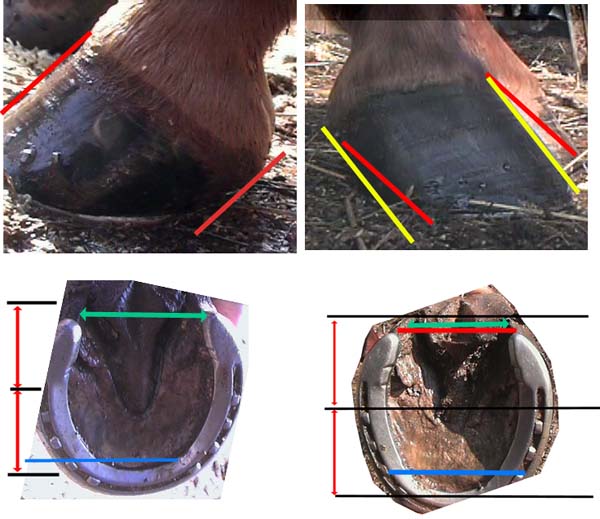
For anyone who may be having a problem understanding why underrun heels are to long and not to short, I posted a pic in the “Hoof/Shoe Problem” thread that should help explain the reasoning behind my maddness… ![]()
Proud member of the * Hoof Fetish Clique *
<BLOCKQUOTE class=“ip-ubbcode-quote”><font size="-1">quote:</font><HR>
How can it correct a broken axis if the angle of the trim still appears to be at the wrong angle? Maybe I just don’t understand.
I should also note that his hoof walls are not symmetrical, one side being higher than the other and at different angles, front and back, looking generally unbalanced. They didn’t look like that 2 years ago…<HR></BLOCKQUOTE>
It sounds like your horse’s feet are overall unbalanced. Look back of some of the pics that I posted and comments that I made addressing unbalanced feet. The feet should be as symetrical as possible, otherwise there is misalignment in the joints…this will eventually result in pain somewhere in the upper body or legs. There really is no excuse for the hoof wall to be unbalanced like this…the farrier must be having lots of “bad hair” days if it is.
As to changing angles through trimming:
This is done all the time…it is how a deformed foundered foot is returned to healthy form. The farrier must realize where the underlying coffin bone is and trim to make the hoof wall parallel the same planes. The angles are set by nature, but the farrier’s hand changes them everytime he/she trims. Sometimes the changes are positive, sometimes (as it sounds in your case) the changes are negative.
In the case of long toes…most likely the toe is slightly dished…generally the upper 1/4-1/3 (depending on severity of deformation) of the hoof wall is growing at a correct angle. The toe hasn’t really started growing at a “wrong” angle, it has started to stretch and seperate at the white line and thus the forces of the long toe have pushed it out and away from the parallel connection with the coffin bone. The connection at the bottom of the toe (depending on how severe the stretching/seperation is) is just causing problems for the horse and is not of any value anyway because it is usually damaged. By cutting it back, the leverage is relieved and the hoof wall can now grow straight at the correct angle from the coronary band. This is sometimes refered to as “unloading” the hoof wall…this relief of forces on the wall allows it to grow as it was intended. The same is true of flares that form on the side of the foot. Farriers generally understand not to leave them, it just doesn’t make sense that they don’t understand not to leave one at the toe…they are identical.
As the hoof grows, if the toe is kept at a proper length, it will allow the hoof to keep growing parallel to the coffin bone…the angle it was intended to be at. Once the angle of the hoof wall is back in parallel with P3, as long as the heels are the correct height, then there cannot be a broken axis.
As the toes come back, the heels will also follow…just as they did when the toes crept forward. They will need to be trimmed (many times farriers back up the toes, but do not trim heels thinking that they are too low) to help return them to the widest part of the frog. Look back up the page and find Redpony’s post…it has great examples of how the hoof angles and heels can be changed in just a couple of trims.
As to the low angles on the heels…they are either crushed or underrun. There are at least a half a dozen posts with drawings on what the angles should look like throughout this thread. Since I refuse to pay to post pics…I can’t do that anymore, but they are mostly already there…you just need to find them. Probably if you run a search for my name, it will be easier to find them. When the toes get out of control, the forces on them cause the heels to follow forward. This in turn generally makes the bars start to curve. When the bars straighten, then you know that the forces are balanced and the toe and heel are in correct alignment.
Hope this helps… ![]()
Proud member of the * Hoof Fetish Clique *
slb, I’m new to this thread and you seem to have lots of insights into foot managment. My question to you (I might have missed the answer somewhere and for that I appologize) is, where do you get all your information?
Ohhhh Bensmom, you must be sooo happy ![]()
Proud member of the * Hoof Fetish Clique *
Hi all!
OK, I agree that his feet looked better at the track. Libby, I think you’re really onto something as well. If this injury was sustained in his racing career, maybe it’s not an issue until his feet got out of shape? You know? I mean, he certainly wasn’t lame when I got him.
Now, the sickening thing … he has pulled both eggbars off within one week. I know, $182.50 that could’ve been my 2 new sets of leathers at Rolex, I hardly knew ye!
My farrier is doing what I tell him, and from now on, too, we are cutting off the heels and setting back the shoe and growing back the heel! I agree that his foot is naturally conformed to have more heel than what is apparent now. We likely will do pour-ins as well (Equibuild) to help as we grow back the heel.
Mellsmom - since Rhodey came from Harrisburg, PA, I’d be hard pressed to find his farrier! But a good thought nonetheless!
Thanks again all! I swear, I wish Libby would just come play with us for a week!
Robby
“Don’t mince words, don’t be evasive
Speak your mind, be persuasive”
Madonna
here’s the after
“Shoot me now! Shoot me now!”
Bugs Bunny
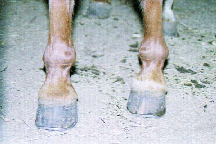
Right Rear…
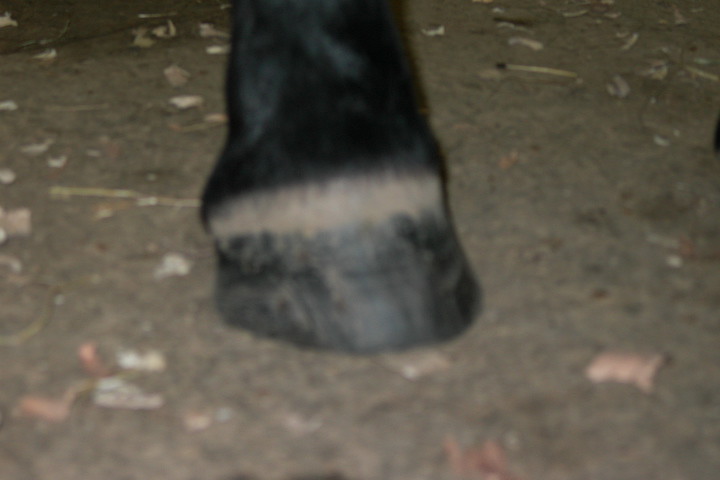
Thanks slb…
More info on the farrier. He had undetected White line for a while (had a resection, almost all the hoof wall was taken off) and typical bad feet. ![]() It wasn’t so much one botched trim, but more of a continual 6 month thing (stupid me, I didn’t know). Its a long story, but my vet, the vets at Rochester Equine, a new farrier there, etc all said thats what it was from. I’m sure you can imagine how terrible I felt…I had no idea.
It wasn’t so much one botched trim, but more of a continual 6 month thing (stupid me, I didn’t know). Its a long story, but my vet, the vets at Rochester Equine, a new farrier there, etc all said thats what it was from. I’m sure you can imagine how terrible I felt…I had no idea.
We too all thought of a metabolic/underlying problem. Actually, my vet thought it was Cushings or insulin problems (only 9 yrs old)…but all the blood work came back clear (did each test 2 times).
The new hoof growth does look better, so as his foot grows out I assume it will look better as it grows out.
The first time he foundered was 2 years ago, and the rotation/sinking was pretty much put back into the correct position. So he really only has rotation on the front 2 now…but his coffin bone is sitting directly on his sole.
He eats a lot less grain (was an OTTB), and also isn’t allowed on grass (most recent founder was because barn workers put him on a new lush paddock for the entire day after being on a dry lot).
Thanks for the answers, I’ll work on the pictures.
~katelyn~
Ok so I admit I didn’t look through this entire thread for info I am searching for, it’s late and I’m pooped. So perhaps wthe answer to my question is in this thread. Someone let me know if it is. But…
My horse is recently barefoot (well 8 weeks now)in the hind per my barn owners request. He has long toes low heels up front and in back. perhaps he has underun heels as well ? (I am just learning all this vocabulary) Anyhoo I read in a CHerry Hill Maximum Hoof Power book that the frog should not rest on the ground in a barefoot shod horse. My horses frog does. Actually if I pick up the hoof and rest a straightedge across the hoof, the frog is higher than the walls of his hoof, esp in the heel area. So therefore he must be resting his weight on his frog more than his hoof wall right? This is bad right? How bad?
Wow, Robby, hate to say this…but I agree. I’ve actually never seen “track feet” look so good. I like the before pix a lot more than the current ones…unless I’m just missing something since the pix are so small. OOPS, now to tell your farrier. Gulp. Good luck! ![]()
![]()
slb- I don’t know how to rasp (nor do I have one/know where to get one) a horse… nor do I understand how to do it WITH the shoe on!
Is the white line you speak of something you saw on my horse or in general (like White Line the condition)?
Just trying to learn… sorry if my questions are odd.
Dressager
California, here we come!!!
Yes, that helps greatly! Thanks!
Robby
“Don’t mince words, don’t be evasive
Speak your mind, be persuasive”
Madonna
another front view
— And how did you feel about being denied these Hungry Hippos?

Rhodey got redone yesterday. He has square toes (much shorter) now, and square toe shoes to match. I guess that’s a good thing.
Will photograph this week.
Robby (just in from Mardi Gras)
“Don’t mince words, don’t be evasive
Speak your mind, be persuasive”
Madonna
front solar
— And how did you feel about being denied these Hungry Hippos?
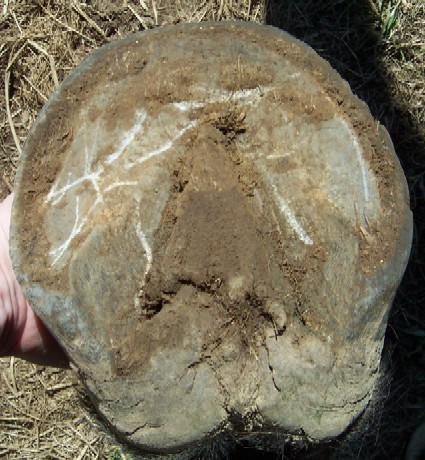
Robby…I’m glad you asked this as it allows some discussion on the important aspects of the differences between domestic and wild hooves.
The main difference that I would suggest is the 20+ miles a day that wild horses travel to eat, drink, and other wise survive. In his new book on founder, Jamie Jackson describes one extreme of what happens when wild horses can’t move. While it may be speculation, it does have some merit. He describes how a small band got “trapped” in a protected area (fenced off from the rest of the BLM reserve) that provided very lush grass, water, and natural mineral licks…everything a horse wants right! They stayed there for days grazing, drinking, licking, and bearly moving to reach any of this. By the end of a few days, they were all severely lame…suspected laminitis/founder. The BLM employee that pointed this band out to Jackson had been following the band for years…there had never been an instance of lameness in any of them until they had this lack of movement. Movement is a key to good hoof health, form, and function. It is imperative that a horse travel at least 15-20 miles/day in order to wear its feet. While this may not be the case for all domestic horses, it is the case for those with good, hard feet as those feet need excessive wear to be self-trimming. Unhealthy feet are generally softer, wear easily, and are often slow growing. Healthy feet produce denser horn and generally grow faster.
The other problem is that we cannot overlook human intervention in domestic horses. You can have a barefoot horse in a “semi- wild” situation, but still need trimming. If there isn’t hundreds, or thousands of acres, varied terrain as you noted (generally abrassive terrain), and if the horse has no motivation to move throughout that acerage, then self-trimming generally will not take place. So, enters the farrier/trimmer.
Unfortunately, the nature of the foot is to run forward (developing a long toe and underrun heel) as that is the “nature of the beast”. The foot sticks out in front of the leg and tends to want to keep growing out there. And, likewise, many farriers/trimmers believe that this is the way the foot “wants to be”, so they keep trimming the foot this way. But, studies now show us that this is not what the foot “wants”, it is what it does when growth is out of control because of lack of self-trimming.
Does this help with the confusion? ![]()
Proud member of the * Hoof Fetish Clique *
Hmm the frog question is interesting… I’ll let the experts take that one. From what I’ve been learning, the frog SHOULD in ideal circumstances (barefeet) be in contact with the ground, at least at maximum weight bearing… but the to extent you describe… hmm
As for long toes, low heels - READ THE THREAD. ![]() It’s why I started it, I have the same problem, along with, oh maybe… 60-90% of the horse population not living in the wild.
It’s why I started it, I have the same problem, along with, oh maybe… 60-90% of the horse population not living in the wild. ![]()
I have some good pictures, I think, of my horse Java - I posted them from December on the first couple pages, and then updates later on in Feb., and there is a nice improvement in some respects. Many many comments here regarding the low heel long toe problem. You will see pictures reflecting this from all of us throughout the post.
martha
martha
Proud member of the * Hoof Fetish Clique *
**Give a person a fish and you feed them for a day; teach that person to use the Internet and they won’t bother you for weeks. **